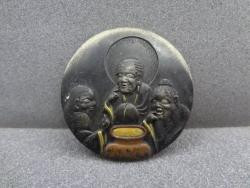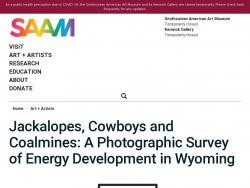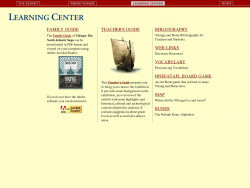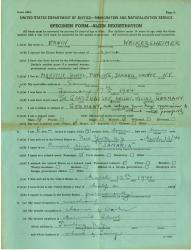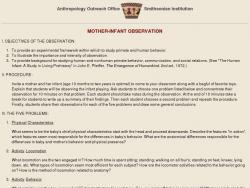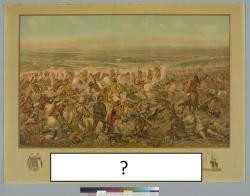Kate Harris
Social Studies teacher
Pittsburgh CAPA
Middle School (13 to 15 years old), High School (16 to 18 years old)
Teacher/Educator
Language Arts And English, Civics, Literature, Cultures, Economics, Social Studies, Geography, Writing, US History, Arts, Other
I'm a history-lover, art fan, and bookworm. I taught high school history (U.S. History and World Religions) for ten years in North Carolina, teach currently in Pittsburgh, PA, and am working to help teachers make the most of this new resource!
Kate Harris's collections
The 1960s--A Decade Collection
<p>This is a topical collection about American life and politics in the 1960s. Resources in this collection might be helpful to students and teachers working on projects about the decade. It is not meant to be completely comprehensive, but rather includes highlights of the Smithsonian's collection spanning art, popular culture, social trends, leadership, and technology.</p><p>Teachers and students might copy and adapt this collection to suit their needs; highlighting a specific aspect of life in the 1960s and adding annotations and additional resources.</p><p>tags: Sixties, Kennedy, Camelot, civil rights, Vietnam, politics, decade</p>
 Kate Harris
Kate Harris
97
The 1980s: A Decade Collection
<p>This is a topical collection about American life and politics in the 1980s. Resources in this collection might be helpful to students and teachers working on projects about the decade. It is not meant to be completely comprehensive, but rather includes highlights of the Smithsonian's collection spanning art, popular culture, social trends, leadership, and technology.</p><p>Teachers and students might copy and adapt this collection to suit their needs; highlighting a specific aspect of life in the 1980s and adding annotations and additional resources.</p><p>tags: Eighties, Reagan, George H. W. Bush, rap, detente, Vietnam, politics, decade, Cold War, Olympics, boycott, space shuttle, star wars, Reaganomics, trickle-down</p>
 Kate Harris
Kate Harris
42
The 1850s and Causes of the Civil War
This collection includes artifacts, stamps, political cartoons, portraits, and videos representing various long-term and short-term causes of the Civil War. Students could use the collection as the basis for a sorting activity:
Which causes are long-term and which are short?
Which represent economic, social, or political differences between the North and South?
Can they be put in chronological order?
Which show attempts at compromise and which show that violence was difficult to avoid?
Additional teaching ideas are listed in the Notes to Other Users section.
 Kate Harris
Kate Harris
33
The Steamboat Arabia
<p style="margin-left:32px;">This collection was made to pair with a learning experience during the November 17th workshop for Pittsburgh teachers working with the Smithsonian Learning Lab. Teachers will visit the Steamboat Arabia exhibit and learn from a Heinz History Center curator about the decisions made and limitations faced when creating an exhibit for visitors to learn from. </p><p style="margin-left:32px;">Both the online collection and the Heinz History Center exhibit explore the question "<strong>How do new innovations in transportation affect American life?"</strong></p><p style="margin-left:32px;">The collection below contains artifacts and images from the Smithsonian collection that might help students and teachers respond to the question above. Suggested scaffolding questions might include:</p><ul><li>Identify the changes in technology and transportation that occurred between 1800-1850.</li><li>How did these new transportation systems impact the movement and interactions of groups of people, the expansion of trade, and cultural life on the frontier?</li><li>How do the items in this collection compare to what was found during the recovery of the Steamboat Arabia?</li></ul>
 Kate Harris
Kate Harris
22
The Three Vinegar Tasters and Daoism
<p>This collection includes a brief overview of Daoism, Confucianism, and Buddhism. It focuses on the story of Laozi and his ideas about the Dao and the balance between yin and yang. It includes two short passages from the Dao de Jing, assessment questions throughout, and a final task where students create their own collection about Daoism.</p><p>Tags: Dao, Confucius, Tao, Buddha, Laozi, China, religion, philosophy</p>
 Kate Harris
Kate Harris
8
The Tuskegee Airmen
The Tuskegee Airmen were the first African-American fighter pilots in the United States military. This collection describes their work and training during an era of segregation, as well as their contributions to World War Two, through videos, photographs, art, and poetry. At the end of the collection, students are asked to write a poem of their own using one of the artifacts as inspiration.
 Kate Harris
Kate Harris
7
Tools of the Labor Movement
The United States labor movement began in full force during the late 19th century and peaked during World War II. Workers learned that by joining together in unions, they could exert more pressure on employers and the government to protect their rights and improve labor conditions. This collection includes a variety of resources related to the United States labor movement, particularly the various tools and strategies used to create change.
Guiding questions to consider are:
-What rights do workers desire?
-How can labor unions influence employers, government, and the public?
-What tools and strategies are most effective for improving working conditions? Consider: boycotts, picketing, appeals to the media, strikes, walk-outs, and slow-downs.
-How does the public perceive labor unions? How does this impact their results?
-Are women and minorities included in the labor movement? Were they always?
 Kate Harris
Kate Harris
25
TRETC Explores the Learning Lab
<p>Let's take a journey to see what the Smithsonian has for you and your students. We will use this as a FRIENDLY challenge, and as a way to explore the types of diverse resources and features found in the Learning Lab.</p>
 Kate Harris
Kate Harris
12
Watch Night
<p>This collection asks students to examine an image entitled "Waiting for the Hour" and to try to determine its meaning and purpose. Students will practice interpretation with justification and then learn more about the history of "watch night services" and the importance of the 1862 watch night in United States history. They will also consider the legacy of this image--a copy is currently hanging in the White House. </p><p>tags: emancipation, freedom, Civil War, Abraham Lincoln, proclamation</p>
 Kate Harris
Kate Harris
4
Weikers Family Collection Class Warm-Up
<p>This is a single document with hot spots and questions used to model primary source analysis for a sixth grade class. It is drawn from a collection of archival records and photographs documenting the Weikers family's experience in Nazi Germany and their persistent efforts to seek asylum in the United States. You can find the full collection here:</p><p>https://learninglab.si.edu/collections/weikers-family-collection/zGJCDjyWqouEufnb</p><p>Questions to consider are:</p><p>a. Who are the Weikers?</p><p>b. Where did they live?</p><p>c. When did they live? What can they tell us about this time in history?</p><p>d. How were they affected by Nazi Germany?</p><p>e. What did they feel about the Nazis?</p><p>Tags: Nazi Germany, Holocaust era, primary sources, Pittsburgh</p>
 Kate Harris
Kate Harris
2
Westinghouse: The Man and the Companies
This is a collection of teaching resources available on the topic of George Westinghouse as well as Westinghouse Electric Company (founded 1886) and its spinoffs (including the broadcasting company and nuclear energy company).
Fun fact: During the 20th century, Westinghouse engineers and scientists were granted more than 28,000 US government patents, the third most of any company (https://en.wikipedia.org/wiki/Westinghouse_Electric_Company#cite_note-2009profile-14)
 Kate Harris
Kate Harris
15


